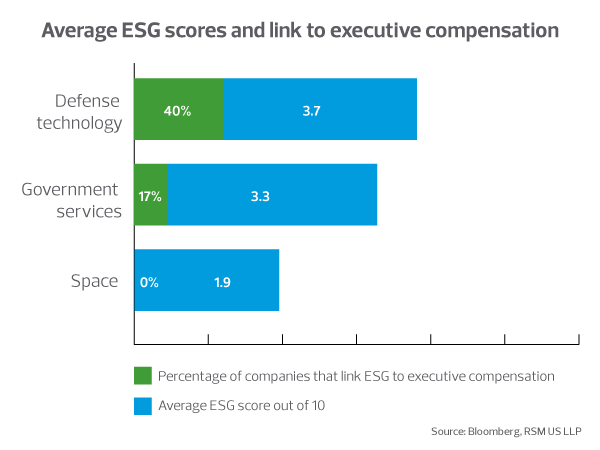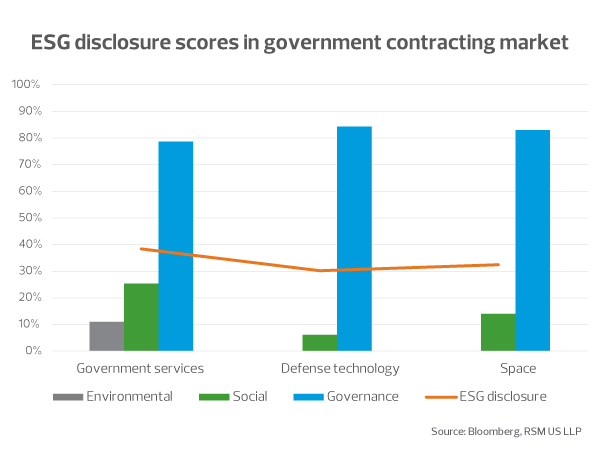This article was originally published on October 6, 2023. It has been updated to reflect the status as a final rule.
An update to the Federal Acquisition Regulation (FAR) focused on environmental and sustainability matters. The new FAR 23 section is titled “Environment, Energy, and Water Efficiency, Renewable Energy Technologies, Occupational Safety, and Drug-Free Workplace.”
This FAR update aligns the defense industrial base with current investment expectations in the commercial market, where environmental, social and governance (ESG) factors are considered a valuable data point in determining business value. Currently, disclosing ESG efforts in the defense industrial base is not a widely established process, so a gradual learning curve is expected. The sooner companies begin this journey, the sooner they will gain confidence to comply with the rule while also attracting more investors.
Aligning the new rule
Executive Order 14057 outlines a coordinated governmental approach to transform federal procurement and operations to reduce greenhouse gas (GHG) emissions and environmental impacts. The order also focuses on securing a transition to clean energy and sustainable technologies. The Department of Defense (DOD), the General Services Administration (GSA), and the National Aeronautics and Space Administration (NASA) are implementing this order by restructuring FAR Part 23. The rule sets the foundation for the government to consolidate the following:
- Goals dedicated to the environment, sustainable acquisition and material safety
- Purchasing program requirements for energy and water efficiency and renewable energy, recovered materials and bio-based products, and ozone-depleting substances and GHGs
- Hazardous and radioactive material requirements
- Federal facility requirements
The new FAR Part 23 would strengthen the government’s commitment to ESG.
ESG efforts among government contractors
To understand the current state of ESG compliance and commitment among government contractors, RSM US LLP gathered Bloomberg’s data on ESG scores and the percentage of companies that link ESG to executive compensation in three major government contracting sectors: government services, defense technology and space. For context, Bloomberg’s ESG scores measure a company’s management of financially material ESG issues, defined as issues that can have an impact on a company’s financial performance, such as revenue streams, operating costs, cost of capital, asset value and liabilities.

As shown, government contractors in each sector scored in the lower half of the range of 1 to 10 and do not currently provide sufficient financial incentives for executives to excel in this category. As such, compliance with reporting and disclosure requirements in government bids and contracts, driven by FAR Part 23, requires a substantial transformation of their business culture and strategy.
From the government’s perspective, FAR Part 23 requires federal agencies to “advance sustainable acquisition by ensuring that 95% of new contract actions for the supply of products and for the acquisition of services (including construction)” are compliant with the sustainable requirements of the rule.
Exceptions apply only if the acquisition involves (i) contracts performed outside of the U.S., unless the agency head determines that such application is in the interest of the U.S., (ii) weapon systems (iii) and if the head of an agency provides an exemption for intelligence or law enforcement activities. The purpose is to:
- Reduce emissions.
- Promote environmental stewardship.
- Support resilient supply chains.
- Drive innovation.
- Incentivize markets for sustainable products and services.
- Purchase sustainable products and services in accordance with relevant statutory requirements.
- Purchase sustainable products and services identified by the Environmental Protection Agency (EPA).
Regarding recovered materials and biobased products, the government states that “agencies shall purchase these products to the maximum extent practicable without jeopardizing the intended use of the product while maintaining a satisfactory level of competition at a reasonable price.”
The phrase “to the maximum extent practicable” is used in similar contexts, such as in the exemption provided under the Buy American Act, where the domestic-content requirement may be waived if procuring a domestic item is impracticable for various reasons, including insufficient quantity or quality. Some flexibility would be likely, depending on the critical need for a company’s end products.
Disclosing ESG data
DOD, GSA and NASA are also proposing a FAR revision to implement section 5(b)(i) of Executive Order 14030, which would require major federal suppliers to publicly disclose GHG emissions and climate-related financial risk and to set science-based reduction targets. This revision would require major and significant contractors to provide their specified tier ranking and evidence of scope 1 and scope 2 inventories and emissions. Major contractors, under scope 3 reporting, would be required to publicly submit their CDP climate change questionnaire and provide online public access to their SBTi-validated science-based targets. Scope 1 pertains to direct GHG emissions, including facilities and vehicles, while scope 2 and scope 3 relate to indirect activities, specifically upstream and downstream, respectively.
Requirements for ESG data disclosure would deviate significantly from the current disclosure practices of the defense industrial base. Using the same set of representative companies in the chart above, RSM gathered the Bloomberg ESG disclosure scores for government contractors in services, defense technology and space, measuring the percentage of ESG data a company reports publicly. As shown in the chart below, companies in these three sectors disclosed, on average, between 30% and 38% of their ESG data.

ESG disclosures would be a new norm for government contractors, as shown above. Clearly, it will be important to weave ESG objectives into the strategy of the organization, leading to downstream operational activities supporting leadership’s vision.
Working with the EPA
Under the proposal to implement Executive Order 14030, federal agencies would be directed to follow the EPA’s recommendations of specifications, standards and eco-labels for federal purchasing. These are designed to help government purchasers identify private-sector standards and eco-labels that meet sustainable acquisition goals and mandates.
Alongside the new proposed rules, the EPA announced that it will extend its recommendations to new product and service categories, including health care, professional services, laboratories, uniforms and clothing, and food-service ware.
The new rules would also direct agencies to avoid the procurement of products containing per- and polyfluorinated substances, or “forever chemicals.”
The takeaway
FAR Part 23 highlights the federal government's commitment to environmental stewardship, energy efficiency and the well-being of its workforce. By integrating these considerations into the procurement process, the government would not only fulfill its responsibilities, but also set a precedent for sustainable and responsible business practices.
The updates to FAR Part 23 align the government with the expectations of the broader business and investment community while demonstrating how regulations can be a driving force for positive change, benefiting both the government and society at large. Based on the current state, government contractors may face a steep road ahead, but not an impossible one. One thing is certain: Integrating ESG into a company’s strategy will be the first step in an actionable plan for success.


